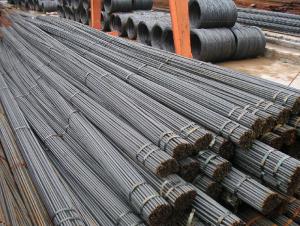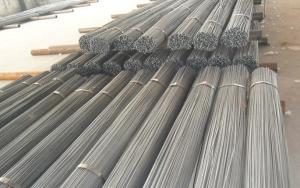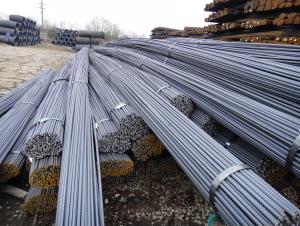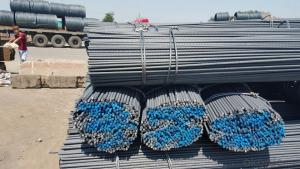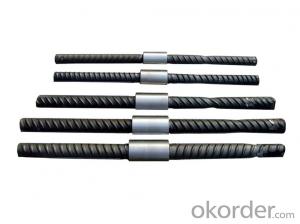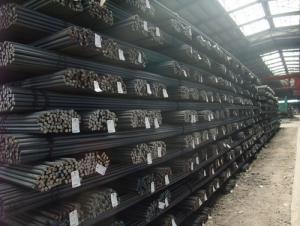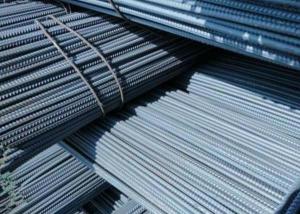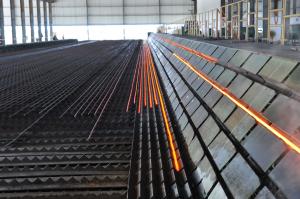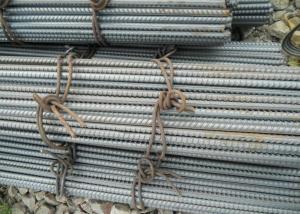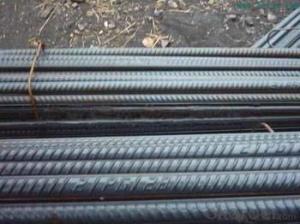Seven mm Cold Rolled Steel Rebars with Good Quality
- Loading Port:
- Tianjin
- Payment Terms:
- TT or LC
- Min Order Qty:
- 100 m.t.
- Supply Capability:
- 15000 m.t./month
OKorder Service Pledge
OKorder Financial Service
You Might Also Like
Specifications of Seven mm Cold Rolled Steel Rebars with Good Quality:
Name | Seven mm Cold Rolled Steel Rebars with Good Quality | |
Diameter | 5mm, 5.5mm, 6mm, 6.5mm, 7mm, 8mm, 9mm, 10mm, 11mm, 12mm, | |
Length | 6M, 9M, 12M or as required | |
Price | Keep lower operating costs so as to offer competitive price for our clients | |
Label | to be specified by customer, generally, each bundle has 1-2 labels | |
Application | Building, construction | |
Invoicing | Actual or Theoretical Weight Basis as buyer’s request. | |
Theoretical weight and section area of each diameter of Seven mm Cold Rolled Steel Rebars with Good Quality as below for your information:
Diameter(mm) | Section area (mm²) | Mass(kg/m) | Weight of 12m (kg) | Pcs/ton |
7 | 38.5 | 0.302 | 3.624 | 275.94 |
Packaging & Delivery of Seven mm Cold Rolled Steel Rebars with Good Quality:
Packaging Detail: products are packed in bundle and then shipped by container or bulk vessel, deformed bar is usually naked strapping delivery, when storing, please pay attention to moisture proof. The performance of rust will produce adverse effect.
Each bundle weight: 2-3MT, or as required
Payment terms: TT payment in advance or Irrevocable LC at sight.
Trade terms :FOB, CFR, CIF
Delivery Detail: within 45 days after received advanced payment or LC.
FAQ:
Q1: Why buy Materials & Equipment from OKorder.com?
A1: All products offered byOKorder.com are carefully selected from China's most reliable manufacturing enterprises. Through its ISO certifications, OKorder.com adheres to the highest standards and a commitment to supply chain safety and customer satisfaction.
Q2: How do we guarantee the quality of our products?
A2: We have established an advanced quality management system which conducts strict quality tests at every step, from raw materials to the final product. At the same time, we provide extensive follow-up service assurances as required.
Q3: How soon can we receive the product after purchase?
A3: Within three days of placing an order, we will arrange production. The shipping date is dependent upon the quatity, how many sizes you want and the plan of production, but is typically 1 month to 2 month days from the beginning of production.
Images of Seven mm Cold Rolled Steel Rebars with Good Quality:
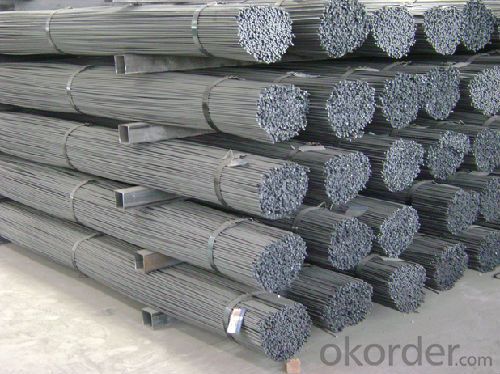

- Q: Are steel rebars suitable for use in seismic zones?
- Yes, steel rebars are suitable for use in seismic zones. Steel rebars are commonly used in construction projects in seismic zones due to their high strength and ductility properties. During an earthquake, buildings and structures experience significant stress and movement, and steel rebars help to reinforce the concrete and provide additional strength and flexibility. This helps to absorb and distribute the energy generated during seismic events, reducing the risk of structural damage or collapse. Additionally, steel rebars are also resistant to corrosion, which is crucial in areas prone to seismic activity as the reinforcement must maintain its integrity over time. Overall, using steel rebars in seismic zones is an effective way to enhance the safety and durability of structures in these high-risk areas.
- Q: What is the relationship between steel structure and thread steel?
- Steel and thread steel are two entirely different concepts. A steel structure is a structural form of a structure, and the thread steel is the name of a material.
- Q: How do steel rebars contribute to the overall sustainability of a project?
- There are several ways in which steel rebars contribute to the overall sustainability of a project. Firstly, their high durability and long lifespan mean they do not need frequent replacement, reducing resource consumption and minimizing the need for new material production. This, in turn, decreases the environmental impact of the project. Moreover, steel rebars are fully recyclable. When they reach the end of their life cycle, they can be easily collected, melted down, and repurposed into new steel products. This recycling process significantly reduces the demand for raw materials, conserves energy, and reduces landfill waste. Additionally, steel rebars provide structural strength and enhance the overall safety and resilience of the project. By reinforcing concrete structures, they increase load-bearing capacity and resistance to external forces like earthquakes or extreme weather events. This ensures the project's longevity and stability, reducing the need for future repairs or reconstruction. Lastly, the use of steel rebars in construction projects often leads to shorter construction time and lower maintenance costs. Their ease of handling and installation allows for efficient construction processes, resulting in reduced energy consumption and lower greenhouse gas emissions. Furthermore, their durability and low maintenance requirements minimize the need for ongoing repairs and replacements, resulting in cost savings over the project's lifespan. In conclusion, steel rebars contribute to the overall sustainability of a project through their durability, recyclability, and ability to enhance structural strength and safety. Their use reduces resource consumption, waste generation, and energy consumption, while also providing long-term cost savings. Incorporating steel rebars in construction projects is a sustainable choice that supports environmental conservation, economic efficiency, and social resilience.
- Q: What is the effect of steel rebars on the thermal conductivity of concrete?
- The effect of steel rebars on the thermal conductivity of concrete is generally negligible. While steel has a higher thermal conductivity than concrete, the relatively low volume fraction of rebars in typical reinforced concrete structures does not significantly impact the overall thermal conductivity of the material.
- Q: Why is the price of screw steel affected by iron ore and coal?
- The required material is simple, "billet, iron ore with a small amount of chemical elements", and then through the hot rolling method of refining, during which a large amount of coal is needed, so the price of rebar will be affected by iron ore and coal
- Q: Are steel rebars suitable for use in aggressive environments?
- Steel rebars are indeed suitable for use in aggressive environments. Steel rebars are commonly used in construction projects, particularly in reinforced concrete structures, due to their high tensile strength and durability. However, in aggressive environments where the rebar is exposed to corrosive elements such as moisture, chloride ions, and chemicals, corrosion can occur, weakening the rebars and compromising the structural integrity of the concrete. To combat this issue, steel rebars are often coated with protective materials like epoxy or zinc to provide a barrier against corrosion. Additionally, stainless steel rebars are also used in aggressive environments due to their superior corrosion resistance properties. In conclusion, while steel rebars are generally suitable for use in aggressive environments, it is crucial to consider the specific conditions and ensure appropriate protective measures are taken to prevent corrosion and maintain the longevity of the reinforced concrete structure.
- Q: How many patterns are there in threaded steel?
- Rebar is ribbed steel, ribbed steel, including rebar. A ribbed steel bar with 2 longitudinal ribs and uniformly distributed ribs along the length. The transverse rib shape is helical, herringbone, crescent 3. Because of the function of rib, it has better bonding ability with concrete, so it can bear the effect of external force better.
- Q: Can steel rebars be used in structures with high alkaline environments?
- Structures with high alkaline environments, like concrete, generally allow for the use of steel rebars. Nevertheless, it is crucial to take into account the potential for corrosion in such environments. The alkaline nature of concrete forms a protective layer, known as a passive film, on the surface of the steel rebar, which aids in preventing corrosion by reducing contact between the steel and corrosive elements. However, several factors can impact the corrosion resistance of steel rebars in high alkaline environments. These factors encompass the quality of the concrete, the presence of chloride ions (which can disrupt the passive film), the extent of environmental exposure, and the design of the structure. Ensuring that high-quality concrete is used and taking measures to minimize the presence of contaminants that may accelerate corrosion are of utmost importance. In cases where the alkaline environment is highly aggressive or the structure is subject to severe conditions, additional protective measures might be required. These measures can include the application of corrosion-resistant coatings or the implementation of cathodic protection systems to mitigate the risk of corrosion. In conclusion, careful consideration of the specific conditions and appropriate measures are essential when using steel rebars in structures with high alkaline environments. Consulting with structural engineers and corrosion specialists can aid in determining the most suitable approach for utilizing steel rebars in such settings.
- Q: Can steel rebars be used in high-strength concrete?
- Indeed, steel rebars have the capability of being utilized in high-strength concrete. In reality, steel rebars are commonly employed to reinforce concrete structures, regardless of the concrete's strength. High-strength concrete pertains to a type of concrete that possesses a significantly higher compressive strength when compared to conventional concrete. Its compressive strength typically exceeds 6,000 psi (pounds per square inch). The presence of steel rebars in high-strength concrete is essential as they provide the necessary tensile strength. Although concrete exhibits commendable compressive strength, its tensile strength is relatively feeble. By incorporating steel rebars into the concrete, the composite material becomes more robust and durable. The rebars act as reinforcement, effectively resisting the tensile forces and averting cracks or structural failure. Nevertheless, it is crucial to emphasize the importance of selecting the appropriate steel rebar for high-strength concrete. The rebars employed must possess adequate strength and ductility to endure the elevated stresses and strains associated with high-strength concrete. Moreover, proper placement, spacing, and anchorage of the rebars are vital to ensure effective reinforcement and optimal performance of the concrete structure. In summary, it is undeniable that steel rebars can certainly be utilized in high-strength concrete to augment its tensile strength and overall structural integrity.
- Q: How do steel rebars resist fire?
- Steel rebars resist fire due to their high melting point and low thermal conductivity. Steel has a melting point of around 1370°C, which is higher than typical temperatures reached in building fires. This allows rebars to maintain their structural integrity even in high-temperature environments. Additionally, steel has a low thermal conductivity, meaning it does not readily transfer heat, minimizing the risk of fire spread and structural failure. The combination of these properties makes steel rebars a reliable choice for reinforcing concrete structures in fire-prone areas.
Send your message to us
Seven mm Cold Rolled Steel Rebars with Good Quality
- Loading Port:
- Tianjin
- Payment Terms:
- TT or LC
- Min Order Qty:
- 100 m.t.
- Supply Capability:
- 15000 m.t./month
OKorder Service Pledge
OKorder Financial Service
Similar products
Hot products
Hot Searches
Related keywords
